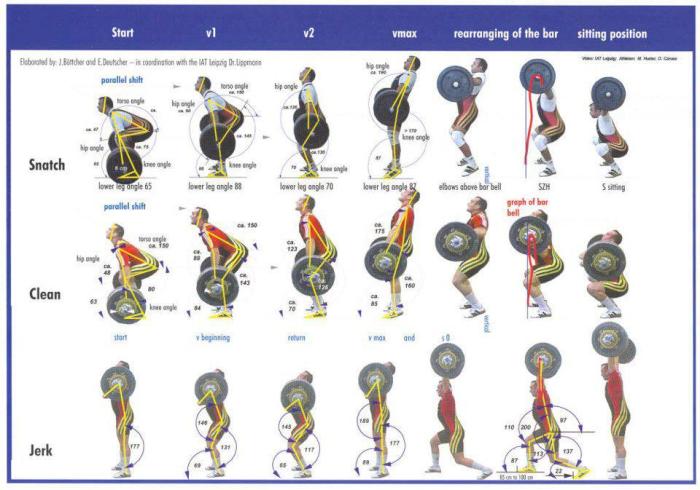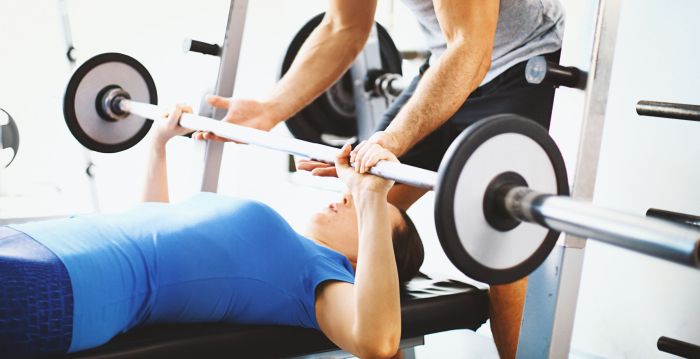Embark on an empowering journey into the world of basic weight lifting, a cornerstone of fitness that unlocks a myriad of benefits. Whether you’re a novice seeking to build strength or an experienced lifter looking to refine your technique, this guide will provide you with a comprehensive understanding of this foundational practice.
Discover the fundamental principles of basic weight lifting, from proper form to exercise selection. Learn how to create a tailored workout plan that aligns with your fitness goals and delve into advanced techniques to maximize your progress. We’ll also cover essential aspects such as nutrition, recovery, and safety considerations, empowering you with the knowledge to embark on your weightlifting journey with confidence.
Benefits of Basic Weight Lifting

Basic weight lifting offers numerous benefits for individuals of all fitness levels. It not only enhances physical strength and aesthetics but also provides long-term health advantages. Here are some key benefits of incorporating basic weight lifting into your fitness routine:
Improve Overall Strength and Muscle Mass
Weight lifting stimulates muscle growth and increases overall strength. By progressively overloading your muscles with external weight, you force them to adapt and become stronger. This leads to improved muscular endurance, power, and functional strength, allowing you to perform daily activities and sports with greater ease and efficiency.
Enhance Bone Density
Weight lifting exerts stress on bones, which triggers the body’s natural response to strengthen and increase bone density. Regular weight-bearing exercises can help prevent osteoporosis, a condition that weakens bones and makes them more susceptible to fractures. By increasing bone mineral content, weight lifting promotes bone health and reduces the risk of bone-related injuries.
Boost Metabolism
Weight lifting increases muscle mass, which in turn boosts your metabolism. Muscle tissue is more metabolically active than fat, meaning it burns more calories even at rest. By building muscle through weight lifting, you can elevate your basal metabolic rate (BMR), allowing you to burn more calories throughout the day and support weight management efforts.
Reduce the Risk of Injury
Stronger muscles and bones provide better support for joints and connective tissues. Weight lifting strengthens muscles around joints, enhancing stability and reducing the risk of sprains, strains, and other injuries. By improving balance, coordination, and proprioception (body awareness), weight lifting promotes overall physical fitness and reduces the likelihood of accidents or falls.
Designing a Basic Weight Lifting Program

Designing a basic weight lifting program is essential for achieving your fitness goals. It involves determining your goals, choosing appropriate exercises, setting a training schedule, and progressing gradually.
Determine Fitness Goals
Before creating a weight lifting program, it’s crucial to establish your fitness objectives. These could include building muscle, losing weight, or improving strength. Identifying your goals will help you tailor your program accordingly.
Choose Appropriate Exercises
Selecting exercises that target specific muscle groups is essential. Consider exercises like squats, lunges, push-ups, rows, and bench press. Choose exercises that you can perform with proper form and that challenge you without compromising technique.
Set a Training Schedule
Consistency is key in weight lifting. Determine how often you can train and stick to a regular schedule. Start with 2-3 days per week and gradually increase frequency as you progress. Rest days are equally important for muscle recovery and growth.
Progress Gradually
Overloading your muscles is essential for progress. Gradually increase the weight, sets, or reps over time to challenge your body and stimulate muscle growth. However, avoid progressing too quickly, as this can lead to injury.
Sample Basic Weight Lifting Workout Plan

To create an effective weight lifting workout plan, it’s important to incorporate basic exercises that target multiple muscle groups. This plan provides a comprehensive routine for beginners, focusing on proper form and progressive overload.
Exercise Selection
The following exercises are essential for a well-rounded weight lifting program:
- Barbell Squats
- Dumbbell Lunges
- Bench Press
- Overhead Press
- Barbell Rows
- Planks
Sets, Reps, and Rest Periods
Sets refer to the number of times you complete an exercise, while reps indicate the number of repetitions within each set. Rest periods allow your muscles to recover and prepare for the next set.
- For beginners, aim for 2-3 sets of 10-12 repetitions per exercise.
- Rest for 60-90 seconds between sets to allow for proper recovery.
Workout Schedule
Start with 2-3 days of weight lifting per week, allowing for rest days in between. As you progress, you can gradually increase the frequency and intensity of your workouts.
Sample Workout Plan
Here’s a sample workout plan for beginners:
- Day 1:Barbell Squats, Dumbbell Lunges, Bench Press
- Day 2:Rest
- Day 3:Overhead Press, Barbell Rows, Planks
- Day 4:Rest
- Day 5:Repeat Day 1
- Day 6:Rest
- Day 7:Rest
Variations of Basic Weight Lifting Exercises

Variations of basic weight lifting exercises offer endless possibilities for customizing your workouts and targeting specific muscle groups. By altering the position of your body, the equipment used, or the tempo of the movement, you can modify exercises to suit your fitness level, goals, and preferences.
Exercise Modifications for Different Fitness Levels
Modifying exercises is essential for both beginners and experienced lifters. Beginners can start with lighter weights and fewer sets, gradually increasing intensity as they progress. Experienced lifters can modify exercises to challenge themselves, prevent plateaus, and target specific muscle groups.
Examples of Modifiable Exercises
Almost any basic weight lifting exercise can be modified. Here are a few examples:
- Push-ups:Can be modified by elevating your hands on a bench or wall, or by performing them on your knees.
- Squats:Can be modified by using a lighter weight, performing them without weight, or by using a resistance band.
- Lunges:Can be modified by using a shorter or longer stride, or by holding dumbbells or a kettlebell.
- Rows:Can be modified by using a lighter weight, performing them with one arm, or by using a different grip.
- Overhead press:Can be modified by using a lighter weight, performing them with one arm, or by using a different grip.
Table of Variations and Modifications
The following table summarizes some common variations and modifications of basic weight lifting exercises:
| Exercise | Variation | Modification |
|---|---|---|
| Push-ups | Incline push-ups | Knee push-ups |
| Squats | Bodyweight squats | Banded squats |
| Lunges | Forward lunges | Reverse lunges |
| Rows | Barbell rows | Dumbbell rows |
| Overhead press | Barbell overhead press | Dumbbell overhead press |
Tips for Modifying Exercises
- Start with a light weight and gradually increase it.
- Choose a variation that is appropriate for your fitness level.
- Focus on proper form.
- Listen to your body and rest when needed.
- Be patient and consistent.
Benefits of Modifying Exercises
Modifying exercises offers several benefits, including:
- Increased safety:Modifications can help to reduce the risk of injury.
- Improved form:Modifications can help you to focus on proper form, which can lead to better results.
- Greater muscle activation:Modifications can help you to target specific muscle groups more effectively.
- Increased workout variety:Modifications can help you to keep your workouts interesting and challenging.
Call to Action
If you’re looking to improve your weight lifting routine, try modifying some of your exercises. With a little creativity and effort, you can create a workout that is tailored to your specific needs and goals.
Advanced Basic Weight Lifting Techniques

As you progress in your weightlifting journey, incorporating advanced techniques can enhance your workouts and accelerate your results. These techniques, when used safely and effectively, can help you lift heavier weights, improve muscle activation, and minimize the risk of injuries.
It’s crucial to note that advanced techniques should be introduced gradually and under the supervision of a qualified trainer. Proper form and technique are paramount to reap the benefits and mitigate potential risks.
Forced Reps
Forced reps involve assistance from a spotter to help you complete additional repetitions beyond muscular failure. This technique can stimulate muscle growth and strength gains by pushing your limits.
- Benefits: Increased muscle activation, enhanced strength gains.
- Risks: Muscle strains or tears if not performed correctly.
Rest-Pause
Rest-pause involves brief rest periods during a set. After reaching momentary failure, you rest for a short duration (10-20 seconds) and then resume the set with the same weight.
- Benefits: Improved muscle endurance, increased time under tension.
- Risks: Potential for muscle fatigue, not suitable for all exercises.
Drop Sets, Basic weight lifting
Drop sets involve reducing the weight immediately after reaching failure and continuing the set. This technique helps target different muscle fibers and promote hypertrophy.
- Benefits: Increased muscle damage, enhanced muscle growth.
- Risks: Muscle fatigue, potential for injury if not performed properly.
Supersets
Supersets involve performing two exercises back-to-back with minimal rest. This technique can increase workout intensity and improve cardiovascular fitness.
- Benefits: Enhanced calorie expenditure, improved muscle endurance.
- Risks: Potential for muscle fatigue, not suitable for all exercises.
Negatives
Negatives involve focusing solely on the eccentric (lowering) phase of an exercise. This technique can help improve muscle strength and size by emphasizing time under tension.
- Benefits: Increased muscle damage, enhanced strength gains.
- Risks: Potential for muscle strains or tears if not performed correctly.
Safety Tips:
- Always consult a qualified trainer before attempting advanced techniques.
- Start with light weights and gradually increase the intensity.
- Use a spotter when performing forced reps or negatives.
- Listen to your body and stop if you experience any pain or discomfort.
Remember, advanced weightlifting techniques should be used as a tool to enhance your progress, not as a shortcut to results. By incorporating these techniques safely and effectively, you can unlock your full potential and take your weightlifting to the next level.
Conclusion

In summary, basic weight lifting offers a range of benefits for overall health and fitness, including increased muscle mass, improved bone density, enhanced cardiovascular health, and reduced body fat. By incorporating basic weight lifting exercises into your routine, you can effectively work towards your fitness goals.For beginners, it’s essential to start gradually and seek guidance from a qualified personal trainer or healthcare professional.
Remember to prioritize proper form, use appropriate weights, and listen to your body to avoid injuries.
Benefits of Basic Weight Lifting
| Benefit | Explanation |
|---|---|
| Increased Muscle Mass | Weight lifting stimulates muscle growth, leading to increased strength and power. |
| Improved Bone Density | Weight-bearing exercises help strengthen bones, reducing the risk of osteoporosis and fractures. |
| Enhanced Cardiovascular Health | Weight lifting improves heart health by lowering blood pressure and reducing cholesterol levels. |
| Reduced Body Fat | Weight lifting increases metabolism, helping to burn calories and reduce body fat. |
Before starting any new exercise program, it’s crucial to consult with a healthcare professional to determine if it’s right for you.
Summary
As you incorporate basic weight lifting into your fitness routine, you’ll not only witness physical transformations but also experience a profound sense of accomplishment. Embrace the challenge, stay consistent, and reap the countless rewards that this empowering practice has to offer.
Remember, the path to fitness is a journey, and basic weight lifting is a powerful tool that will begleiten you every step of the way.
FAQ Compilation
What are the benefits of basic weight lifting?
Basic weight lifting offers a multitude of benefits, including increased strength, enhanced bone density, boosted metabolism, and reduced risk of injury.
How do I choose the right weights for my workouts?
When selecting weights, it’s crucial to consider your fitness level and goals. Start with a weight that challenges you while maintaining good form. Gradually increase the weight as you progress.
How often should I do basic weight lifting exercises?
Aim to incorporate basic weight lifting exercises into your routine 2-3 times per week, allowing for adequate rest and recovery between workouts.
What are some common mistakes to avoid in basic weight lifting?
Common mistakes include using improper form, lifting too heavy too soon, neglecting warm-ups and cool-downs, and overtraining. Focus on maintaining proper technique, listening to your body, and progressing gradually.
How can I modify basic weight lifting exercises for my fitness level?
Modify exercises by adjusting the weight, sets, reps, or range of motion. For example, if an exercise is too challenging, reduce the weight or perform fewer reps. Gradually increase the intensity as you get stronger.
Leave a Reply